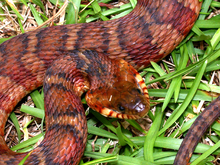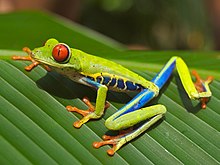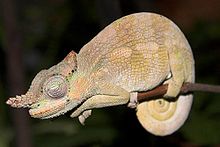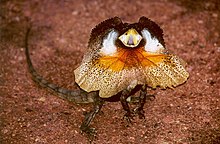terrarium
Terrariums (from Latin terra "land, earth") are containers and plants, the terrarium for keeping various animals and plants operate. In contrast to aquariums , the land portion and / or the air space dominates. Aquariums and terrariums are grouped under the umbrella term vivariums . Terrariums are usually made of glass , plastic or wood and can be seen on at least one side.
The habitat of the animals or plants kept in the terrarium is often reproduced in a smaller space. The terrarium keeper tries to adapt the air conditioning: temperature , humidity , water values and lighting are controlled, including their seasonal and daily fluctuations.
Popular terrarium plants include cacti , bromeliads , orchids , ferns , mosses and aquatic plants . On the one hand there are pure plant terrariums; on the other hand, vertebrates - for example reptiles, amphibians or small mammals - and invertebrates - z. B. insects, spiders, crabs or scorpions - held.
Terrariums have to be adapted to the needs of the creatures they keep. In many cases, terrariums are planned and built by the terrarium owner himself. There are different terrariums depending on the stocking, construction and purpose:
Terrarium types
- Aquaterrarium : The generic term aquaterrariums refers to terrariums that consist of a water and a land part. There are many transitional forms of an aquaterrarium. The most important subforms are:
- Paludarium : A paludarium (Latin palus = swamp) reproduces a swamp landscape. It is characterized by a relatively small and shallow water content and is equipped with many plants.
- Riparium : The term riparium (Latin ripa = bank) stands for a terrarium shape with a bank landscape. It is characterized by a larger proportion of water than in a paludarium.
- Rivarium: A rivarium (lat. Rivus = stream) is a terrarium in which a stream is reproduced.
- Forest terrarium: This type of terrarium reproduces semi-humid or semi-dry forest landscapes. With its temperature and humidity values, it lies between a dry terrarium and a rainforest terrarium.
- Rainforest terrarium : In this type of terrarium, the water part is relatively small. In a rainforest terrarium, the habitat of plants and animals from the humid tropics is reproduced.
- Dry terrarium: As an umbrella term, a dry terrarium is understood to mean all heated and dry terrariums. Depending on the decoration, the plants and the animal husbandry, a distinction is made between:
- Desert terrarium: A desert is reproduced here. The substrate in this terrarium consists of a deep layer of sand or a mixture of clay and sand. A desert terrarium is only sparsely planted with a maximum of 2 plants, a root and / or a cactus skeleton.
- Steppe terrarium: In a steppe terrarium, the transition zone between a desert and a savannah is reproduced.
- Savannah terrarium: A savannah terrarium replicates a wide plain with resistant plants, woods and stones. Agave plants, small prickly pear species and bow hemp can be used to make it more rich than a steppe terrarium.
- Rock terrarium: A rock landscape is reproduced in a rock terrarium.
- Outdoor terrarium: An outdoor terrarium is understood to be systems that are designed for (temporarily) keeping outdoors. A distinction is made between the following sub-forms:
- Arid landscapes: They mimic the habitat of toads , lizard species and certain tortoises.
- Wetlands: In a marshland habitat of will newts , toads and toads simulated.
- Pond landscapes: The habitat for frogs , salamanders , snakes and turtles is imitated by a pond landscape.
- Quarantine terrarium: In a quarantine terrarium, newly acquired or sick animals are temporarily isolated from other animals in order to avoid the transmission of diseases.
- Formicarium : A formicarium is a terrarium that reproduces the natural habitat of an ant species.
- Insectarium : In an insectarium the natural habitat of an insect species is reproduced.
Further classification options result e.g. B. from: Format, size and material, water content and temperature, location and purpose, or the animal or plant species, z. B. at the bottle garden
Terrarium plants
Under Terrarienpflanzen refers living or artificial plants that are located in a terrarium. The word terrarium plant is a compound from "terrarium" (from the Latin terra "land, earth") and " plant ".
A distinction is made between pure plant terrariums and terrariums with additional keeping of different animals. In the reproduced habitat of the terrarium, the planting and animal husbandry are dependent on their natural environment, depending on the type and requirements.
Terrarium animals
A wide variety of animal species can be kept in a terrarium. Depending on the type of terrarium, the following table shows examples of different animal species.
| Terrarium type | Animal species | Biological systematics | Lifestyle / peculiarities | image | |
|---|---|---|---|---|---|
| Aquaterrarium |
|
|
|
||
| Aquaterrarium |
|
|
|
||
| Aquaterrarium |
|
|
|
||
| Aquaterrarium |
|
|
|
||
| Forest terrarium |
|
|
|
||
| Forest terrarium |
|
|
|
||
| Forest terrarium |
|
|
|
||
| Forest terrarium |
|
|
|
||
| Rainforest terrarium |
|
|
|
||
| Rainforest terrarium |
|
|
|
||
| Rainforest terrarium |
|
|
|
||
| Aquaterrarium |
|
|
|
||
| Dry terrarium |
|
|
|
||
| Dry terrarium |
|
|
|
||
| Dry terrarium |
|
|
|
temperature
If possible, a terrarium should simulate natural temperature fluctuations (day and night rhythm). Different heat sources are integrated depending on the type of animal and the corresponding type of terrarium. As a rule, most terrarium animals are so-called cold - blooded animals . They include the reptiles, amphibians and invertebrates . In order to maintain their body temperature , the cold blooded animals depend on the ambient temperature. In order to reach a body temperature at which their metabolism functions optimally, they depend on these external sources of heat. So need z. B. the cold-blooded animals to increase their body temperature adapted conditions to the terrarium. A heat source in the form of radiation is often required, the values of which should be above the respective air temperature. A high water or air temperature or a warm contact surface (e.g. heating stones) may also be required.
humidity
Precipitation, soil moisture and relative humidity (RH) are very important in a terrarium. The ideal values are u. a. depends on the respective animal husbandry. If the terrarium is too dry, z. B. geckos are very bad, on the other hand, molds often appear in containers that are too damp. Many animal species in dry terrariums, for example, need an additional moist shelter made of peat moss or sand in order to lay their eggs there. An increase in the relative humidity is achieved by using a humidifier, a heated water section or by "spraying".
Gravel
The choice of soil substrate depends on the type of terrarium and the corresponding animal and / or plant husbandry . For most substrates, germ reduction can be achieved by heating them in the oven beforehand. The most common substrates include:
- Aquarium gravel: This should only be used in the water part of the terrarium, as it can lead to blockages in certain species if eaten. Waste materials can settle in the aquarium gravel, so regular cleaning is necessary.
- Expanded clay: The advantage lies in the ability to absorb moisture, so it is particularly suitable for the quarantine terrarium. The granulate must be replaced regularly because of dirt particles that can settle between the pellets. In rainforest terrariums, expanded clay is often installed as a drainage layer and separated from the actual substrate by a water-permeable fleece.
- Potting soil: A substrate for dry terrariums is old potting soil. Under no circumstances should this soil contain perlite or pesticides , as these can be harmful to terrarium animals. Potting soil can rot quickly and smell bad if it gets wet.
- Tree bark and foliage soil: reptiles find hiding places or egg-laying places in them. They are an ideal substrate for plants, and tree bark and foliage soil also look natural. Since they tend to form mold and germs, they must be disinfected in advance by means of dry heating. As a destructor z. B. earthworms are added, as waste is broken down naturally.
- Floor covering: A floor covering enables optimal cleaning and can thus be kept largely free of parasites and dirt.
- Wood shavings: They are suitable for keeping snakes , as they like to dig into them. In lizards and turtles, there is a risk of constipation from swallowing individual chips .
- Artificial turf: The advantage lies in the hygiene , because artificial turf can be cleaned without any problems.
- Coconut humus: Coconut humus is suitable for terrariums and their inhabitants that require high humidity, as coconut humus has a very high storage capacity for water.
- Pieces of cork: They offer hiding places, e.g. B. for the giant tarantula.
- Maize pellets: Maize pellets are suitable for dry terrariums in which there is no digging. They are harmless and also edible as dry food.
- Moss: As a substrate, moss is suitable for wet terrariums with amphibians. It can store plenty of water and release moisture relatively evenly. Amphibians can build moist loopholes from peat moss. While it dies quickly, it does not tend to rot quickly.
- Orchid substrate: The sieved substrate is suitable for rainforest terrariums . It hardly rots and has little tendency to mold.
- Bark shavings: Beech bark shavings are often used. They look natural and dirt can be easily removed. Bark chips are rather unsuitable for rainforest terrariums, as they tend to form mold.
- Sand: The substrate is suitable for many terrarium animals. Since it absorbs liquid from excrement and thus forms a breeding ground for bacteria, it must be replaced regularly. Sand has the ability to store heat, which in combination with underfloor heating can lead to overheating. Due to its grain structure, quartz sand does not stick together easily. The orange-colored clay sand hardens when it gets wet and is therefore particularly suitable for desert animals that burrow in caves.
- Forest soil: Forest soil is understood to mean normal soil substrate that has been inoculated with some soil from the forest. The microorganisms and small animals added in this way create a kind of natural equilibrium in which it is no longer necessary to fertilize the plants or replace the substrate, as waste materials are broken down naturally. This type of substrate is particularly suitable for densely planted forest and rainforest terrariums.
Back walls
Back walls offer additional climbing possibilities, donate protection and are decorative. With the additional extension of terraces, the action space is also increased. Different materials are available for the design of the different types of terrariums and for keeping animals. Are used u. a. Cork panels , cork bark , peat panels, colored styrofoam or simple wooden panels. Tree fern plates ("Mexifarn") are also used in paludariums, although many countries now prohibit the export of this material because the tropical tree ferns are endangered.
ventilation
To ensure that animals kept do not suffer from a lack of oxygen, a constant exchange of air must take place in a terrarium . The formation of condensation , mold and rot are also prevented by good ventilation. Radiators that are mounted in front of an aluminum-coated screen cause air to be circulated as the warm air rises and fresh air is sucked in. Small computer fans are also suitable. Very humid terrariums, such as the aqua or rainforest terrarium, can also be ventilated through grids on the lower edge of the front pane or on the lid, whereby it must be ensured that there is no draft .
lighting
Regardless of temperature, many species begin a dormant period as the length of the day decreases. With lighting, the light duration of the country of origin of the animals and plants is simulated as precisely as possible. So show z. B. many reptiles only with sufficient lighting their optimally pronounced colors. The plants in a terrarium also need a light source for the necessary photosynthesis . Different lamps are often installed in one lighting box. Depending on the type of terrarium, animal and plant husbandry, different light sources are suitable:
- Energy-saving lamps: The advantage of these lamps is that they are usually moisture-proof. Compared to the other types of lighting, however, they give off a rather “cold” light.
- Incandescent lamps: Incandescent lamps radiate a lot of heat on all sides, so that the temperature in the terrarium remains more or less constant. However, the required temperature of 35 degrees Celcius is often not reached. Incandescent lamps also only emit an insufficient amount of light, and the color spectrum of natural light is also inadequately reproduced. (Sub) tropical animal species require a light intensity that is adapted to their natural habitats, which is around 100,000 lux in full sun and only 200 - 500 lux on the floor of a rainforest. Light bulbs are therefore only used for nocturnal insects, spiders, scorpions, amphibians and reptiles.
- Halogen lamps: They emit a wide range of colors with UV radiation , have a high light intensity and give off a lot of heat. Small halogen lamps are suitable for small terrariums.
- Ceramic radiant heaters: They give off a lot of heat but no light. They are mostly used to warm a large terrarium at night.
- Fluorescent lamps: These lamps give off little heat but a lot of light. They are also an energy-saving light source. These lamps are particularly suitable for a paludarium .
- High-pressure mercury lamps: These HQL lamps are characterized by a high light output and radiate a lot of heat. These lights are suitable for medium to large steppe and desert terrariums.
- Emitters: Emitters cause a temperature gradient in a terrarium, as heat and light are concentrated on one spot. At a height of 30 cm, a room temperature of 35 to 45 ° C is achieved with 40 watt lamps.
literature
- Günther Nietzke: The terrarium animals. Volume 1-3. Ulmer Verlag, Stuttgart 1989–2002, ISBN 3-8001-7178-3 .
- Hagen Schmidt: terrarium plants. Ulmer Verlag, Stuttgart 2003, ISBN 3-8001-3935-9 .
- Eugène Bruins: Terrarium Encyclopedia. Dörfler Verlag, Eggolsheim 2006, ISBN 3-89555-423-5 .
- Oliver Drewes: Terrarium animals from A - Z. Graefe and Unzer Verlag, Munich 2004, ISBN 3-7742-6316-7 .
- Friedrich Wilhelm Henkel, Wolfgang Schmidt: Invertebrates for the terrarium. Eugen Ulmer, Stuttgart 2010, ISBN 978-3-8001-5156-1 .
Web links
- German Society for Herpetology and Terrarium Science
- http://www.mikes-hobby-blog.de/2012/07/23/waldboden-lebender-boden-im-bepflanzten-terrarium/
Individual evidence
- ↑ Oliver Drewes: Terrarientiere von A - Z. Gräfe and Unzer Verlag, Munich 2004, ISBN 3-7742-6316-7 , p. 171.
- ↑ a b Oliver Drewes: Terrarium animals from A - Z. Gräfe and Unzer Verlag, Munich 2004, ISBN 3-7742-6316-7 , p. 43.
- ↑ Oliver Drewes: Terrarium animals from A - Z. Graefe and Unzer Verlag, Munich 2004, ISBN 3-7742-6316-7 , p. 50.
- ↑ Oliver Drewes: Terrarientiere von A - Z. Gräfe and Unzer Verlag, Munich 2004, ISBN 3-7742-6316-7 , p. 67.
- ↑ Oliver Drewes: Terrarientiere von A - Z. Gräfe and Unzer Verlag, Munich 2004, ISBN 3-7742-6316-7 , p. 68.
- ↑ Oliver Drewes: Terrarientiere von A - Z. Gräfe and Unzer Verlag, Munich 2004, ISBN 3-7742-6316-7 , p. 154.
- ^ Eugène Bruins: Terrarium Encyclopedia. Dörfler Verlag, Eggolsheim 2006, ISBN 3-89555-423-5 , p. 32.















